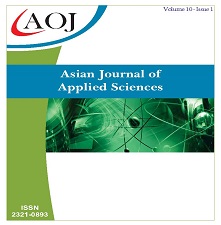Study of Drug Production and Quality Control Process in Factories: A Case Study in Tolid Mavade Avallieh Daroupakhsh
DOI:
https://doi.org/10.24203/ajas.v10i1.6922Keywords:
Pharmaceutical companies, quality control, Tolid Mavade Avallieh DaroupakhshAbstract
Tolid Mavade Avallieh Daroupakhsh Company is known as the largest producer of pharmaceutical active pharmaceutical ingredients in the Middle East and as one of the reputable companies in the field of production of narcotic and non-narcotic products worldwide.In addition to production, this complex has not neglected to consider environmental issues. In this regard, for many years, environmental protection has been seriously on its agenda, and since 2007, with the formation of an independent unit called "Production Support Unit" has followed this path more seriously. The first task of pharmaceutical manufacturers is to ensure the safety and effectiveness of their products. It is important only in the case of continuous quality control methods. For this reason the company has various departments including management, accounting, administrative and commercial affairs, planning manager, technical manager, laundry, warehouse manager, control laboratory, production control, synthesis, formulation, production management, production manager, packaging, coating, Facilities, technical management of warehouse, packaging and active pharmaceutical ingredients. Tests performed by a chemist on active pharmaceutical ingredients and drug quality are performed in a controlled laboratory. Other tasks include quality control and assurance and the development of control methods to ensure and match the production process with good GMP production operations. In the new pharmacy, another task is the responsibility of this department, and that is to ensure the compatibility of biological studies and clinical tests with good laboratory operations GLP and good clinical operations GCP. For example, these operations will be controlled by the quality control and assurance department, and their compliance with GCP, GMP, GLP is confirmed. All of these cases are discussed in detail in this paper.
References
Harbison, C.E., et al., "Scientific and Regulatory Policy Committee Points to Consider: Biological Sample Retention From Nonclinical Toxicity Studies", Toxicologic Pathology, p. 01926233211049156, 2021.
Ajit, C.P., A.M. Bhagwat, and A.P. Chaudhari, "CAPA: An important concept of Quality Assurance in Pharmaceutical Industry", Asian Journal of Research in Chemistry, vol. 14, no. 5, p. 357-362, 2021.
Shaikh, R., et al., "Pharmaceutical cocrystal drug products: an outlook on product development", Trends in pharmacological sciences, vol. 39, no. 12, p. 1033-1048, 2018.
Sabouhi, F., M.S. Pishvaee, and M.S. Jabalameli, "Resilient supply chain design under operational and disruption risks considering quantity discount: A case study of pharmaceutical supply chain", Computers & Industrial Engineering, vol. 8, no. 126, p. 657-672, 2018.
Cunha, S., et al., "Improving drug delivery for Alzheimer’s disease through nose-to-brain delivery using nanoemulsions, Nanostructured Lipid Carriers (NLC) and in situ hydrogels", International Journal of Nanomedicine, vol. 16, p. 4373, 2021.
Alqahtani, M.S., "Advances in oral drug delivery", Frontiers in Pharmacology, vol. 12, p. 62, 2021.
Boyd, B.J., et al., "Successful oral delivery of poorly water-soluble drugs both depends on the intraluminal behavior of drugs and of appropriate advanced drug delivery systems", European Journal of Pharmaceutical Sciences, vol. 137: p. 104967, 2019.
Karagianni, A., M. Malamatari, and K. Kachrimanis, "Pharmaceutical cocrystals: new solid phase modification approaches for the formulation of APIs", Pharmaceutics, vol. 10, no. 1, p. 18, 2018.
Araújo, A.S., et al., "Key Information Related to Quality by Design (QbD) Applications in Analytical Methods Development", Braz. J. Anal. Chem, vol. 8, p. 14-28, 2021.
Achanta, P.S., et al., "Quantum mechanical NMR full spin analysis in pharmaceutical identity testing and quality control", Journal of Pharmaceutical and Biomedical Analysis, vol. 192: p. 113601, 2021.
Dao, H., et al., "Microbial stability of pharmaceutical and cosmetic products", Aaps Pharmscitech, vol. 19, no. 1, p. 60-78, 2018.
Wang, D., et al., "Selecting optimal pharmaceutical excipient formulation from life cycle assessment perspectives: A case study on ibuprofen tablet formulations", Journal of Cleaner Production, vol. 292, p. 126074, 2021.
Molavi, F., M. Barzegar-Jalali, and H. Hamishehkar, "Polyester based polymeric nano and microparticles for pharmaceutical purposes: A review on formulation approaches", Journal of Controlled Release, vol. 320, p. 265-282, 2018.
Downloads
Published
Issue
Section
License
Copyright (c) 2022 Mohammad Torkashvand, Atefeh Hasan-Zadeh

This work is licensed under a Creative Commons Attribution-NonCommercial 4.0 International License.
- Papers must be submitted on the understanding that they have not been published elsewhere (except in the form of an abstract or as part of a published lecture, review, or thesis) and are not currently under consideration by another journal published by any other publisher.
- It is also the authors responsibility to ensure that the articles emanating from a particular source are submitted with the necessary approval.
- The authors warrant that the paper is original and that he/she is the author of the paper, except for material that is clearly identified as to its original source, with permission notices from the copyright owners where required.
- The authors ensure that all the references carefully and they are accurate in the text as well as in the list of references (and vice versa).
- Authors retain copyright and grant the journal right of first publication with the work simultaneously licensed under a Attribution-NonCommercial 4.0 International that allows others to share the work with an acknowledgement of the work's authorship and initial publication in this journal.
- Authors are able to enter into separate, additional contractual arrangements for the non-exclusive distribution of the journal's published version of the work (e.g., post it to an institutional repository or publish it in a book), with an acknowledgement of its initial publication in this journal.
- Authors are permitted and encouraged to post their work online (e.g., in institutional repositories or on their website) prior to and during the submission process, as it can lead to productive exchanges, as well as earlier and greater citation of published work (See The Effect of Open Access).
- The journal/publisher is not responsible for subsequent uses of the work. It is the author's responsibility to bring an infringement action if so desired by the author.


